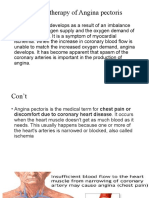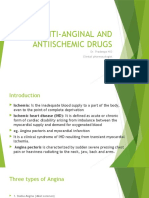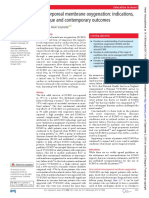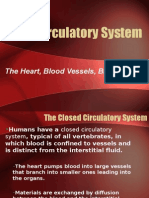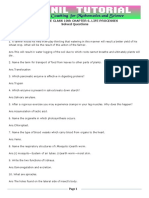0 ratings0% found this document useful (0 votes)
105 viewsPharmacology Angina
Pharmacology Angina
Uploaded by
alijanmarwatThis document discusses drugs used to treat angina pectoris, or chest pain due to reduced blood flow to the heart. It describes three major classes of antianginal drugs: organic nitrates, beta-blockers, and calcium channel blockers. Organic nitrates like nitroglycerin relieve chest pain by dilating blood vessels and reducing workload on the heart. Beta-blockers lower heart rate and pressure, reducing oxygen demand. Calcium channel blockers inhibit calcium influx into heart and blood vessel cells, reducing constriction.
Copyright:
Attribution Non-Commercial (BY-NC)
Available Formats
Download as PPTX, PDF, TXT or read online from Scribd
Pharmacology Angina
Pharmacology Angina
Uploaded by
alijanmarwat0 ratings0% found this document useful (0 votes)
105 views28 pagesThis document discusses drugs used to treat angina pectoris, or chest pain due to reduced blood flow to the heart. It describes three major classes of antianginal drugs: organic nitrates, beta-blockers, and calcium channel blockers. Organic nitrates like nitroglycerin relieve chest pain by dilating blood vessels and reducing workload on the heart. Beta-blockers lower heart rate and pressure, reducing oxygen demand. Calcium channel blockers inhibit calcium influx into heart and blood vessel cells, reducing constriction.
Original Title
pharmacology-angina-
Copyright
© Attribution Non-Commercial (BY-NC)
Available Formats
PPTX, PDF, TXT or read online from Scribd
Share this document
Did you find this document useful?
Is this content inappropriate?
This document discusses drugs used to treat angina pectoris, or chest pain due to reduced blood flow to the heart. It describes three major classes of antianginal drugs: organic nitrates, beta-blockers, and calcium channel blockers. Organic nitrates like nitroglycerin relieve chest pain by dilating blood vessels and reducing workload on the heart. Beta-blockers lower heart rate and pressure, reducing oxygen demand. Calcium channel blockers inhibit calcium influx into heart and blood vessel cells, reducing constriction.
Copyright:
Attribution Non-Commercial (BY-NC)
Available Formats
Download as PPTX, PDF, TXT or read online from Scribd
Download as pptx, pdf, or txt
0 ratings0% found this document useful (0 votes)
105 views28 pagesPharmacology Angina
Pharmacology Angina
Uploaded by
alijanmarwatThis document discusses drugs used to treat angina pectoris, or chest pain due to reduced blood flow to the heart. It describes three major classes of antianginal drugs: organic nitrates, beta-blockers, and calcium channel blockers. Organic nitrates like nitroglycerin relieve chest pain by dilating blood vessels and reducing workload on the heart. Beta-blockers lower heart rate and pressure, reducing oxygen demand. Calcium channel blockers inhibit calcium influx into heart and blood vessel cells, reducing constriction.
Copyright:
Attribution Non-Commercial (BY-NC)
Available Formats
Download as PPTX, PDF, TXT or read online from Scribd
Download as pptx, pdf, or txt
You are on page 1of 28
Antianginal Drugs
1. Angina pectoris
• Angina pectoris, commonly
known as angina, is severe
chest pain due to ischemia (a
lack of blood, hence a lack of
oxygen supply) of the heart
muscle, generally due to
obstruction or spasm of the
coronary arteries (the heart's
blood vessels).
• It is caused by coronary blood
flow that is insufficient to meet
the oxygen demands of the
myocardium, leading to
ischemia.
• The imbalance between oxygen delivery and
utilization may result during exertion, from a
spasm of the vascular smooth muscle, or from
obstruction of blood vessels caused by
atherosclerotic lesions.
• These transient episodes (15 seconds to 15
minutes) of myocardial ischemia do not cause
cellular death, such as occurs in myocardial
infarction.
• Options other than medications for treating
angina include angioplasty and coronary
artery bypass surgery.
2. Major risk factors
• Age (≥ 55 for men, ≥ 65 for women)
• Cigarette smoking
• Diabetes mellitus (DM)
• Dyslipidemia
• Family History
• Hypertension (HTN)
• Kidney disease
• Obesity
• Physical inactivity
• Medications
3.Types of Angina
A. Stable angina
• Stable angina is the most common form of angina and,
therefore, is called typical angina pectoris.
• It is characterized by a burning, heavy, or squeezing feeling
in the chest.
• It is caused by the reduction of coronary perfusion due to a
fixed obstruction produced by coronary atherosclerosis.
• The heart becomes vulnerable to ischemia whenever there
is increased demand, such as that produced by physical
activity, emotional excitement, or any other cause of
increased cardiac workload.
• Typical angina pectoris is promptly relieved by rest or
nitroglycerin (a vasodilator).
B. Unstable angina
• Unstable angina lies between stable angina on the one
hand and myocardial infarction on the other.
• In unstable angina, chest pains occur with increased
frequency and are precipitated by progressively less
effort.
• The symptoms are not relieved by rest or
nitroglycerin.
• Unstable angina requires hospital admission and
more aggressive therapy to prevent death and
progression to myocardial infarction.
C. Prinzmetal's or variant or vasospastic angina
• Prinzmetal's angina is an uncommon pattern of episodic
angina that occurs at rest and is due to coronary artery
spasm.
• Symptoms are caused by decreased blood flow to the heart
muscle due to spasm of the coronary artery.
• Although individuals with this form of angina may have
significant coronary atherosclerosis, the angina attacks are
unrelated to physical activity, heart rate, or blood pressure.
• Prinzmetal's angina generally responds promptly to
coronary vasodilators, such as nitroglycerin and calcium-
channel blockers.
D. Mixed forms of angina
• Patients with advanced coronary artery
disease may present with angina episodes
during effort as well as at rest, suggesting the
presence of a fixed obstruction associated
with endothelial dysfunction.
Treatment
Drugs Classification
Three classes of drugs, used either
alone or in combination, are
effective in treating patients with
angina.
These agents lower the oxygen
demand of the heart by affecting
blood pressure, venous return,
heart rate, and contractility.
Treatment
1. Organic Nitrates
• Organic nitrates (and nitrites) used in the
treatment of angina pectoris are simple nitric
and nitrous acid esters of glycerol.
• These compounds cause a rapid reduction in
myocardial oxygen demand, followed by rapid
relief of symptoms.
• They are effective in stable and unstable
angina as well as in variant angina pectoris.
A. Mechanism of action (MOA)
• Nitrates decrease coronary vasoconstriction
or spasm and increase perfusion of the
myocardium by relaxing coronary arteries.
• In addition, they relax veins, decreasing
preload and myocardial oxygen
consumption.
• Organic nitrates, such as nitroglycerin,
which is also known as glyceryl trinitrate,
are thought to relax vascular smooth muscle
by their intracellular conversion to nitrite
ions, and then to nitric oxide, which in turn
activates guanylate cyclase and increases
the cells' cyclic guanosine monophosphate
(GMP). Elevated cGMP ultimately leads to
dephosphorylation of the myosin light Effects of nitrates and nitrites on
chain, resulting in vascular smooth muscle smooth muscle. cGMP = cyclic
relaxation guanosine 3', 5'-monophosphate.
B. Effects on the cardiovascular system
• All these agents are effective, but they differ in
their onset of action and rate of elimination.
• For prompt relief of an ongoing attack of
angina precipitated by exercise or emotional
stress, sublingual (or spray form) nitroglycerin
is the drug of choice.
• At therapeutic doses, nitroglycerin has two major
effects. First, it causes dilation of the large veins,
resulting in pooling of blood in the veins.
• This diminishes preload (venous return to the
heart) and reduces the work of the heart.
• Second, nitroglycerin dilates the coronary
vasculature, providing an increased blood supply
to the heart muscle. Nitroglycerin decreases
myocardial oxygen consumption because of
decreased cardiac work.
C. Pharmacokinetics
• The time to onset of action varies from 1 minute
for nitroglycerin to more than 1 hour for
isosorbide mononitrate.
• Significant first-pass metabolism of nitroglycerin
occurs in the liver. Therefore, it is common to take
the drug either sublingually or via a transdermal
patch, thereby avoiding this route of elimination.
• Isosorbide mononitrate owes its improved
bioavailability and long duration of action to its
stability against hepatic breakdown.
• Oral isosorbide dinitrate undergoes denitration to
two mononitrates, both of which possess
antianginal activity.
Time to peak effect and duration of
action for some common organic nitrate
preparations
D. Adverse effects
• The most common adverse effect
of nitroglycerin, as well as of the
other nitrates, is headache.
• High doses of organic nitrates can
also cause postural hypotension,
facial flushing, and tachycardia.
• Sildenafil (Viagra) potentiates the
action of the nitrates. To preclude
the dangerous hypotension that
may occur, this combination is
contraindicated.
2. β-Adrenergic Blockers
• The β-adrenergic blocking
agents decrease the oxygen
demands of the myocardium
by lowering both the rate and
the force of contraction of the
heart.
• They suppress the activation of
the heart by blocking β1
receptors, and they reduce the
work of the heart by
decreasing heart rate,
contractility, cardiac output,
and blood pressure.
• With β-blockers, the demand for oxygen by the
myocardium is reduced both during exertion and at
rest.
• Propranolol is the prototype for this class of
compounds, but it is not cardioselective. Thus, other β-
blockers, such as metoprolol or atenolol, are preferred.
• All β-blockers are nonselective at high doses and can
inhibit β2 receptors. This is particularly important to
remember in the case of asthmatics.
• Agents with intrinsic sympathomimetic activity (for
example, pindolol) are less effective and should be
avoided in angina.
• The β-blockers reduce the frequency and severity of
angina attacks. These agents are particularly useful in
the treatment of patients with myocardial infarction
and have been shown to prolong survival.
• The β-blockers can be used with nitrates to
increase exercise duration and tolerance. They
are, however, contraindicated in patients with
asthma, diabetes, severe bradycardia,
peripheral vascular disease, or chronic
obstructive pulmonary disease.
• Note: It is important not to discontinue β-
blocker therapy abruptly. The dose should be
gradually tapered off over 5 to 10 days to
avoid rebound angina or hypertension.
3. Calcium-Channel Blockers
• Calcium is essential for muscular contraction. Calcium
influx is increased in ischemia because of the
membrane depolarization that hypoxia produces.
• In turn, this promotes the activity of several
adenosine triphosphate consuming enzymes, thereby
depleting energy stores and worsening the ischemia.
• The calcium-channel blockers protect the tissue by
inhibiting the entrance of calcium into cardiac and
smooth muscle cells of the coronary and systemic
arterial beds.
• All calcium-channel blockers are therefore arteriolar
vasodilators that cause a decrease in smooth muscle
tone and vascular resistance.
• Verapamil mainly affects the myocardium, whereas
nifedipine exerts a greater effect on smooth muscle in
the peripheral vasculature.Diltiazem is intermediate
in its actions.
• All calcium-channel blockers lower blood pressure.
They may worsen heart failure due to their negative
inotropic effect.
• Variant angina caused by spontaneous coronary
spasm rather than by increased myocardial oxygen
requirement is controlled by organic nitrates or
calcium-channel blockers; β-blockers are
contraindicated.
A. Nifedipine
• Nifedipine, a dihydropyridine derivative, functions mainly as
an arteriolar vasodilator. This drug has minimal effect on
cardiac conduction or heart rate.
• Other members of this class, amlodipine, nicardipine, and
felodipine, have similar cardiovascular characteristics except
for amlodipine, which does not affect heart rate or cardiac
output.
• Nifedipine is administered orally, usually as extended-
release tablets.
• It undergoes hepatic metabolism to products that are
eliminated in both urine and the feces.
• The vasodilation effect of nifedipine is useful in the
treatment of variant angina caused by spontaneous
coronary spasm.
• Nifedipine can cause flushing, headache, hypotension, and
peripheral edema as side effects of its vasodilation activity.
• As with all calcium-channel blockers,
constipation is a problem. Because it has little
to no sympathetic antagonistic action,
nifedipine may cause reflex tachycardia if
peripheral vasodilation is marked.
• The general consensus is that short-acting
dihydropyridines should be avoided in
coronary artery disease.
B. Verapamil
• The diphenylalkylamine verapamil slows cardiac
atrioventricular (AV) conduction directly, and decreases
heart rate, contractility, blood pressure, and oxygen demand.
• Verapamil causes greater negative inotropic effects than
nifedipine, but it is a weaker vasodilator.
• The drug is extensively metabolized by the liver; therefore,
care must be taken to adjust the dose in patients with liver
dysfunction.
• Verapamil is contraindicated in patients with preexisting
depressed cardiac function or AV conduction abnormalities.
It also causes constipation. Verapamil should be used with
caution in patients taking digoxin, because verapamil
increases digoxin levels.
C. Diltiazem
• Diltiazem has cardiovascular effects that are similar to
those of verapamil. Both drugs slow AV conduction and
decrease the rate of firing of the sinus node pacemaker.
• Diltiazem reduces the heart rate, although to a lesser
extent than verapamil, and also decreases blood pressure.
• In addition, diltiazem can relieve coronary artery spasm
and, therefore, is particularly useful in patients with variant
angina. It is extensively metabolized by the liver.
• The incidence of adverse side effects is low (the same as
those for other calcium-channel blockers). Interactions with
other drugs are the same as those indicated for verapamil.
Some common adverse
effects of the calcium-
channel blockers
END
You might also like
- Clinical Management of Congenital Heart DiseaseDocument398 pagesClinical Management of Congenital Heart Diseasejampana Laxmi Narayana Varma100% (2)
- MCQ Cardiology 1Document7 pagesMCQ Cardiology 1Dian ParamitaNo ratings yet
- Anti Anginal DrugsDocument26 pagesAnti Anginal DrugsAtharva PuranikNo ratings yet
- Calcium Channel Blocker (CCB)Document36 pagesCalcium Channel Blocker (CCB)Nafisa TasnimNo ratings yet
- PHARMACOLOGYDocument58 pagesPHARMACOLOGYjosephdeborah60No ratings yet
- Lecture 8 CVS Antianginal Drugs - 061613Document42 pagesLecture 8 CVS Antianginal Drugs - 061613kaleemmasoodNo ratings yet
- 2 Antianginal 2Document10 pages2 Antianginal 2schoolashaq2002No ratings yet
- Angina PectorisDocument31 pagesAngina PectorisShimmering MoonNo ratings yet
- Antianginal DrugsDocument36 pagesAntianginal DrugscreativejoburgNo ratings yet
- Drugs of CvsDocument32 pagesDrugs of CvsAgus HaryantoNo ratings yet
- Chapter 37 Cardiac Glycosides Antianginals and AntidysrhythmicsDocument5 pagesChapter 37 Cardiac Glycosides Antianginals and AntidysrhythmicsErika Joy Cabison TamayoNo ratings yet
- Anti AnginaDocument16 pagesAnti AnginaAik NoeraNo ratings yet
- Antianginal Drugs DR Hussam 2023Document12 pagesAntianginal Drugs DR Hussam 2023ManWol JangNo ratings yet
- Antianginal Drugs BTP II SEMDocument27 pagesAntianginal Drugs BTP II SEMrahulxah14No ratings yet
- Anti AnginaDocument16 pagesAnti AnginarizkyNo ratings yet
- Pharma DR - Zahraa Antianginaldrug Lab 5Document24 pagesPharma DR - Zahraa Antianginaldrug Lab 5rkh647m7szNo ratings yet
- Pharmacology of Ischemic Heart DiseaseDocument51 pagesPharmacology of Ischemic Heart DiseaseabenezergebrekirstosNo ratings yet
- Angina Set #8Document26 pagesAngina Set #8Zaid Al-KadhimiNo ratings yet
- Antianginal Drugs BTP II SEM-1Document26 pagesAntianginal Drugs BTP II SEM-1rahulxah14No ratings yet
- Pharmacology Assignment 3Document31 pagesPharmacology Assignment 3Tujiyye kooNo ratings yet
- Antianginal DrugsDocument21 pagesAntianginal DrugsMaryam Shoukat Ali100% (1)
- Antianginal DrugsDocument29 pagesAntianginal Drugshanyia simpleNo ratings yet
- Pharmacology AssignmentDocument10 pagesPharmacology Assignmentfatimasadiq973No ratings yet
- Management of Ischemic Heart DiseaseDocument13 pagesManagement of Ischemic Heart Diseaseusamahh4334No ratings yet
- III) Pharmacotherapy of Angina PectorisDocument23 pagesIII) Pharmacotherapy of Angina PectorisAyro Business CenterNo ratings yet
- AntianginalDocument29 pagesAntianginalSohail SheikhNo ratings yet
- Anti Anginal DrugsDocument33 pagesAnti Anginal DrugsMuhammad AhmadNo ratings yet
- Anti Anginal DrugsDocument60 pagesAnti Anginal DrugsPranish SawantNo ratings yet
- Antianginal 171115034620Document34 pagesAntianginal 171115034620benny christantoNo ratings yet
- Angina AssignmentDocument7 pagesAngina AssignmentvictoriaNo ratings yet
- Erasmus Heart DrugsDocument90 pagesErasmus Heart DrugsDanilo ČešljaracNo ratings yet
- Chapter 12 Vasodilators and Angina PectorisDocument7 pagesChapter 12 Vasodilators and Angina PectorisChristine Annmarie TapawanNo ratings yet
- Drugs Used in Myocardial InfarctionDocument53 pagesDrugs Used in Myocardial InfarctionSandeep KannegantiNo ratings yet
- Angina, Debkantha Gope PDFDocument9 pagesAngina, Debkantha Gope PDFdebkantha gopeNo ratings yet
- Case AnalysisDocument5 pagesCase AnalysisCharm TanyaNo ratings yet
- Anti-Anginal and Antiischemic Drugs: Dr. Pradeepa H D Clinical PharmacologistDocument25 pagesAnti-Anginal and Antiischemic Drugs: Dr. Pradeepa H D Clinical PharmacologistpradeephdNo ratings yet
- Kee: Pharmacology, 8th EditionDocument5 pagesKee: Pharmacology, 8th EditionLondera BainNo ratings yet
- Drugs for ACS and Drugs Affeting HematologicDocument62 pagesDrugs for ACS and Drugs Affeting HematologicwekesacarrenNo ratings yet
- 8B - Antianginal DrugsDocument72 pages8B - Antianginal Drugsmashe1No ratings yet
- Pharmacotherapy of Ischemic Heart DiseaseDocument120 pagesPharmacotherapy of Ischemic Heart Diseasediwakar4123sawNo ratings yet
- Ischemic Heart DiseaseDocument25 pagesIschemic Heart DiseaseRupesh MohandasNo ratings yet
- Antianginal Drugs.. Prof. Dr. Adeeb Al-ZubaidyDocument19 pagesAntianginal Drugs.. Prof. Dr. Adeeb Al-ZubaidySara AbbasNo ratings yet
- Antihypertensive DrugsDocument30 pagesAntihypertensive Drugsgony1No ratings yet
- med chem unit 2Document65 pagesmed chem unit 2Kirtiman SinghNo ratings yet
- Coronary Artery DiseaseDocument22 pagesCoronary Artery DiseaseMamoon Rashid100% (1)
- Antianginal Drugs Lecture NotesDocument10 pagesAntianginal Drugs Lecture NotesPrincewill SeiyefaNo ratings yet
- Drugs Used in Heart FailureDocument27 pagesDrugs Used in Heart Failurealeah morenoNo ratings yet
- Vasodilators and The Treatment of Angina PectorisDocument24 pagesVasodilators and The Treatment of Angina PectorisKriselda May TorioNo ratings yet
- Angina Pectoris: Chest Pain Due To Ischemia of Heart MusclesDocument27 pagesAngina Pectoris: Chest Pain Due To Ischemia of Heart MusclesJavar SodicNo ratings yet
- Antianginal DrugsDocument3 pagesAntianginal DrugsSarah MendozaNo ratings yet
- 8B - Antianginal DrugsDocument70 pages8B - Antianginal Drugslalitrajindolia100% (2)
- Drugs For CHF & Angina PDFDocument15 pagesDrugs For CHF & Angina PDFAbdullah ElsayedNo ratings yet
- 2.drugsusedforthetreatmentofmi 121112230936 Phpapp02Document38 pages2.drugsusedforthetreatmentofmi 121112230936 Phpapp02omar khanNo ratings yet
- Angina FinalDocument29 pagesAngina Finalkerowael223No ratings yet
- Anti Anginal Drugs - Wards HandooutDocument24 pagesAnti Anginal Drugs - Wards HandooutDharun RanganathanNo ratings yet
- Anti Anginal DrugsDocument26 pagesAnti Anginal DrugsAsif Ali LashariNo ratings yet
- Vasodil - Ischemic Heart DiseaseDocument52 pagesVasodil - Ischemic Heart DiseaseNorms YoramNo ratings yet
- Pharmacology Misbah PDFDocument238 pagesPharmacology Misbah PDFRiham Khamis86% (7)
- Ischemic Heart DiseaseDocument31 pagesIschemic Heart DiseaseRohit SahNo ratings yet
- K. 3. Drug Management of Angina PectorisDocument30 pagesK. 3. Drug Management of Angina PectorisPatrick SangulubeNo ratings yet
- Atrial Fibrillation A Simple Guide to The Condition, Treatment And Related DiseasesFrom EverandAtrial Fibrillation A Simple Guide to The Condition, Treatment And Related DiseasesRating: 4 out of 5 stars4/5 (1)
- Critical Care Medications: Vasopressors, Inotropes and Anti-Hypertensives Study Guide: Critical Care EssentialsFrom EverandCritical Care Medications: Vasopressors, Inotropes and Anti-Hypertensives Study Guide: Critical Care EssentialsNo ratings yet
- Best Pharmacology-Dentistry PDFDocument30 pagesBest Pharmacology-Dentistry PDFalijanmarwat100% (1)
- L87 - Oral Hypoglycemic AgentsDocument17 pagesL87 - Oral Hypoglycemic AgentsalijanmarwatNo ratings yet
- Antiepileptic Drugs-Good LectureDocument55 pagesAntiepileptic Drugs-Good LecturealijanmarwatNo ratings yet
- Ocular Drug Delivery SystemDocument30 pagesOcular Drug Delivery SystemalijanmarwatNo ratings yet
- Circulatory System PPT 1Document47 pagesCirculatory System PPT 1Czarae VillanuevaNo ratings yet
- Py 3 - Science - Respiratory & Circular SysDocument7 pagesPy 3 - Science - Respiratory & Circular SysVijaya LakshmiNo ratings yet
- Transport Across CapillariesDocument21 pagesTransport Across CapillariesDoc HamsNo ratings yet
- Intrauterine Fetal Death: College of Health SciencesDocument49 pagesIntrauterine Fetal Death: College of Health SciencesAce TabioloNo ratings yet
- Sample: Analyzing The Heart With EKGDocument12 pagesSample: Analyzing The Heart With EKGJonathanNo ratings yet
- 1800 MCQ Revised VersionDocument606 pages1800 MCQ Revised VersionFarah FarahNo ratings yet
- Summary of Doshas, Dhatus and Ojas.Document3 pagesSummary of Doshas, Dhatus and Ojas.AnandUnniNo ratings yet
- AIIMS Pharmacology May 2017 - 180517151700Document16 pagesAIIMS Pharmacology May 2017 - 180517151700SelvaArockiamNo ratings yet
- Unit 6 Human Biology Biology Lecture NotesDocument6 pagesUnit 6 Human Biology Biology Lecture NotesGrace Melissa ChoiNo ratings yet
- Extracorporeal Membrane Oxygenation: Indications, Technique and Contemporary OutcomesDocument7 pagesExtracorporeal Membrane Oxygenation: Indications, Technique and Contemporary OutcomesLucas Montanha100% (1)
- MurmursDocument3 pagesMurmursSijo SunnyNo ratings yet
- Circulatory SystemDocument51 pagesCirculatory SystemTina TalmadgeNo ratings yet
- Versión: 1: Surgical Instrumentation ProgramDocument10 pagesVersión: 1: Surgical Instrumentation Programapi-654112138No ratings yet
- Mapa 1: Gusto Neformirano VezivoDocument3 pagesMapa 1: Gusto Neformirano VezivoazraNo ratings yet
- Mediastinum and Cross Sectional Anatomy of The ChestDocument64 pagesMediastinum and Cross Sectional Anatomy of The ChestIbrahim MohammedNo ratings yet
- Case Study For Acute Coronary SyndromeDocument7 pagesCase Study For Acute Coronary SyndromeGabbii CincoNo ratings yet
- Anaesthetic Considerations Patients With Mitral Valve ProlapseDocument7 pagesAnaesthetic Considerations Patients With Mitral Valve ProlapsejaneelsenNo ratings yet
- Learning Guide: Central Texas College Department of NursingDocument26 pagesLearning Guide: Central Texas College Department of Nursingapi-3697326No ratings yet
- PIHDocument18 pagesPIHArtyom GranovskiyNo ratings yet
- Study Guide 1 Case Studies 1 and 2 Gutierrez, W.Document3 pagesStudy Guide 1 Case Studies 1 and 2 Gutierrez, W.Winell Gutierrez100% (1)
- Anaesthesia in First Degree Atrioventricular Block: 37, Pages 1190-1 194Document5 pagesAnaesthesia in First Degree Atrioventricular Block: 37, Pages 1190-1 194achmad mustikaNo ratings yet
- Cbse Class 10th Chapter 6. Life Processes Solved QuestionsDocument5 pagesCbse Class 10th Chapter 6. Life Processes Solved QuestionsDeepakNo ratings yet
- Part of The Body Unit 4 Answer Sheet: Student Name: Ramjas Tuasalamony Student ID Number: 1420119058Document4 pagesPart of The Body Unit 4 Answer Sheet: Student Name: Ramjas Tuasalamony Student ID Number: 1420119058Ra TuasalamonyNo ratings yet
- Components of Health Related FitnessDocument51 pagesComponents of Health Related FitnessAndrea Danica BernasNo ratings yet
- Ventricular Assist DeviceDocument12 pagesVentricular Assist DevicesamadonyNo ratings yet
- Chapter-8 Anatomy, Physiology and Kinseology Class-11Document11 pagesChapter-8 Anatomy, Physiology and Kinseology Class-11Vikash Malhotra50% (2)
- SE5l, Medical-Surgical Review Curse PowerPointDocument104 pagesSE5l, Medical-Surgical Review Curse PowerPointBluebloodboy100% (2)
- Valvular Heart DiseaseDocument6 pagesValvular Heart DiseaseShafiq ZahariNo ratings yet
























